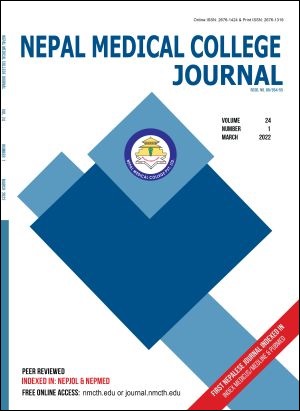Correlation of American College of Radiology (ACR)-Thyroid Imaging Reporting and Data System (TIRADS) findings in Ultrasonogram (USG) of thyroid nodules with FNAC or Biopsy findings
DOI:
https://doi.org/10.3126/nmcj.v24i1.44105Keywords:
ACR-TIRADS, biopsy, FNAC, nodule, thyroid gland, ultrasonographyAbstract
Thyroid Imaging Reporting and Data System (TIRADS) classifies the different ultrasound patterns of thyroid nodule into different TIRADS classes based on their malignant potential. And ultrasound-guided fine needle aspiration cytology (FNAC) is considered the most accurate method to evaluate thyroid malignancy. A prospective study was carried out during 2020 - 2021 in the Department of Radiology & Imaging of Nepal Medical College and Teaching Hospital, Attarkhel, Jorpati, Kathmandu, Nepal, in which a total of 115 patients underwent ultrasonography of the lesions in one or both lobes or isthmus of the thyroid gland. The patients underwent FNAC or biopsy for these thyroid lesions. This study was carried out to correlate ACR-TIRADS findings in USG of thyroid nodules with FNAC or Biopsy findings. The ages of the patients ranged between 13 years to 77 years, with 72 female patients and 43 male patients. Different varieties of USG features were found in all the different categories of the ACR-TIRADS scoring system. Of total 115 nodules, maximum cases were in TR 3 (33.0%), followed by TR 2 (28.7%), TR 4 (18.3%), TR 1 (13.9%) and TR 5 (6.1%). Cytopathological reports revealed 75.6% of cases to be non-neoplastic. Among neoplastic lesions, 14 (12.2%) were of the indeterminate type of lesions and 14 (12.2%) were malignant nodules. Colloid goiter constituted the majority of non-neoplastic thyroid nodules (39.9%) and papillary carcinoma constituted 8.6% of the cases. The risk of malignancy was 0% for TR 1 and TR2 nodules, 7.9% for TR 3 nodules, 23.9% for TR 4 nodules, and 85.7% for TR 5 nodules. TIRADS score and cytopathological findings correlated well for TR 1, TR 2, and TR 5 lesions but showed less agreement for TR 3 and TR 4 nodules. This might be because of the overlap of USG characteristics between benign and malignant thyroid nodules.
Downloads
Downloads
Published
How to Cite
Issue
Section
License
Copyright (c) 2022 Nepal Medical College Journal

This work is licensed under a Creative Commons Attribution 4.0 International License.
This license enables reusers to distribute, remix, adapt, and build upon the material in any medium or format, so long as attribution is given to the creator. The license allows for commercial use.




